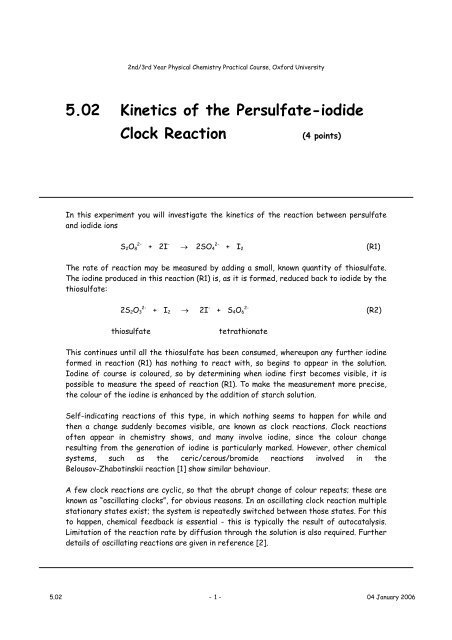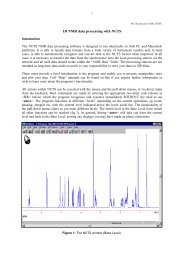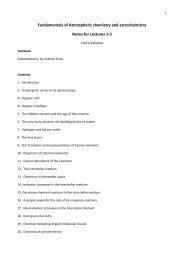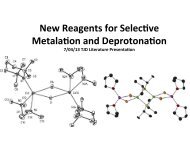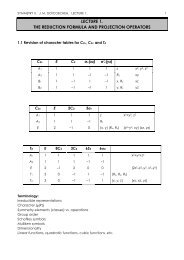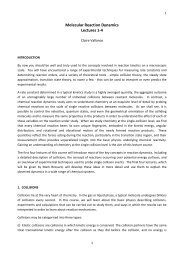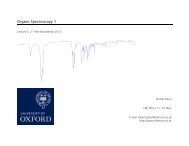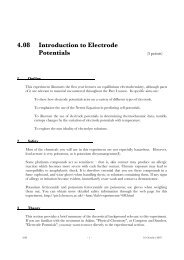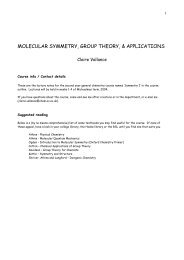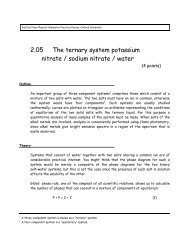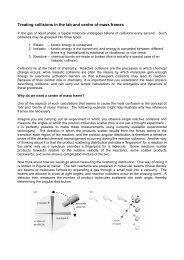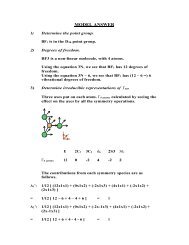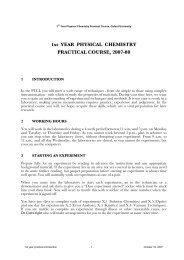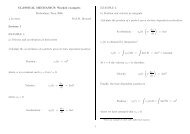5.02 Kinetics of the Persulfate-iodide Clock Reaction
5.02 Kinetics of the Persulfate-iodide Clock Reaction
5.02 Kinetics of the Persulfate-iodide Clock Reaction
Create successful ePaper yourself
Turn your PDF publications into a flip-book with our unique Google optimized e-Paper software.
2nd/3rd Year Physical Chemistry Practical Course, Oxford University<br />
<strong>5.02</strong> <strong>Kinetics</strong> <strong>of</strong> <strong>the</strong> <strong>Persulfate</strong>-<strong>iodide</strong><br />
<strong>Clock</strong> <strong>Reaction</strong> (4 points)<br />
In this experiment you will investigate <strong>the</strong> kinetics <strong>of</strong> <strong>the</strong> reaction between persulfate<br />
and <strong>iodide</strong> ions<br />
S 2 O 8<br />
2-<br />
+ 2I - → 2SO 4<br />
2-<br />
+ I 2 (R1)<br />
The rate <strong>of</strong> reaction may be measured by adding a small, known quantity <strong>of</strong> thiosulfate.<br />
The iodine produced in this reaction (R1) is, as it is formed, reduced back to <strong>iodide</strong> by <strong>the</strong><br />
thiosulfate:<br />
2S 2 O 3<br />
2-<br />
+ I 2 → 2I - + S 4 O 6<br />
2-<br />
(R2)<br />
thiosulfate<br />
tetrathionate<br />
This continues until all <strong>the</strong> thiosulfate has been consumed, whereupon any fur<strong>the</strong>r iodine<br />
formed in reaction (R1) has nothing to react with, so begins to appear in <strong>the</strong> solution.<br />
Iodine <strong>of</strong> course is coloured, so by determining when iodine first becomes visible, it is<br />
possible to measure <strong>the</strong> speed <strong>of</strong> reaction (R1). To make <strong>the</strong> measurement more precise,<br />
<strong>the</strong> colour <strong>of</strong> <strong>the</strong> iodine is enhanced by <strong>the</strong> addition <strong>of</strong> starch solution.<br />
Self-indicating reactions <strong>of</strong> this type, in which nothing seems to happen for while and<br />
<strong>the</strong>n a change suddenly becomes visible, are known as clock reactions. <strong>Clock</strong> reactions<br />
<strong>of</strong>ten appear in chemistry shows, and many involve iodine, since <strong>the</strong> colour change<br />
resulting from <strong>the</strong> generation <strong>of</strong> iodine is particularly marked. However, o<strong>the</strong>r chemical<br />
systems, such as <strong>the</strong> ceric/cerous/bromide reactions involved in <strong>the</strong><br />
Belousov-Zhabotinskii reaction [1] show similar behaviour.<br />
A few clock reactions are cyclic, so that <strong>the</strong> abrupt change <strong>of</strong> colour repeats; <strong>the</strong>se are<br />
known as “oscillating clocks”, for obvious reasons. In an oscillating clock reaction multiple<br />
stationary states exist; <strong>the</strong> system is repeatedly switched between those states. For this<br />
to happen, chemical feedback is essential - this is typically <strong>the</strong> result <strong>of</strong> autocatalysis.<br />
Limitation <strong>of</strong> <strong>the</strong> reaction rate by diffusion through <strong>the</strong> solution is also required. Fur<strong>the</strong>r<br />
details <strong>of</strong> oscillating reactions are given in reference [2].<br />
<strong>5.02</strong> - 1 - 04 January 2006
Background information<br />
You should be able to fully understand <strong>the</strong> <strong>the</strong>ory behind this experiment on <strong>the</strong> basis <strong>of</strong> your<br />
knowledge <strong>of</strong> 1st year kinetics.<br />
Relevant lecture courses: Introduction to <strong>Kinetics</strong> (Hilary term, 1st year); Electrochemistry<br />
(Trinity term, 1st year); States <strong>of</strong> matter (Trinity term, 1st year); <strong>Reaction</strong> <strong>Kinetics</strong> (Michaelmas<br />
term, 2nd year).<br />
Safety<br />
The chemicals that you need for this experiment present a negligible risk to health, apart from<br />
ammonium persulfate, which, in rare cases, may act as a sensitizer.<br />
For fur<strong>the</strong>r information, see <strong>the</strong> safety details at <strong>the</strong> end <strong>of</strong> <strong>the</strong>se instructions, and<br />
http://ptcl.chem.ox.ac.uk/~hmc/tlab/experiments/502.html.<br />
Theory<br />
In Part 1 <strong>of</strong> <strong>the</strong> experiment you will investigate <strong>the</strong> effect <strong>of</strong> reactant concentration on <strong>the</strong> rate<br />
<strong>of</strong> reaction, and <strong>the</strong>reby obtain <strong>the</strong> rate equation. The effect <strong>of</strong> temperature is studied in Part 2,<br />
and <strong>the</strong> results used to find <strong>the</strong> activation energy for <strong>the</strong> reaction. Finally, in Part 3 <strong>the</strong> effect<br />
<strong>of</strong> <strong>the</strong> ionic strength <strong>of</strong> <strong>the</strong> solution on <strong>the</strong> rate is measured, from which a possible structure <strong>of</strong><br />
<strong>the</strong> reaction intermediate may be deduced.<br />
Rate equation<br />
At constant temperature and ionic strength, <strong>the</strong> rate equation for reaction (R1) is<br />
Rate =− d[S 2O 8 2− ]<br />
dt<br />
= k [S 2 O 8 2− ] m [I − ] n<br />
(1)<br />
In this experiment you will use <strong>the</strong> initial rate method to find <strong>the</strong> orders m and n. The rate <strong>of</strong><br />
reaction is measured over a period short enough for <strong>the</strong> reaction not to have proceeded<br />
significantly, but long enough for it to be unaffected by <strong>the</strong> time required for mixing at <strong>the</strong><br />
beginning <strong>of</strong> <strong>the</strong> reaction. (What sort <strong>of</strong> complications do you think might arise if <strong>the</strong> reaction is<br />
monitored for a long period <strong>of</strong> time?)<br />
The stoichiometric equation (R1) tells us that <strong>the</strong> rate <strong>of</strong> consumption <strong>of</strong> persulfate equals <strong>the</strong><br />
rate <strong>of</strong> iodine production. In each experiment, you will measure <strong>the</strong> time, ∆t, taken to consume a<br />
known amount <strong>of</strong> thiosulfate (at which point <strong>the</strong> solution turns blue).<br />
The same amount <strong>of</strong> thiosulfate will be used each time, so <strong>the</strong> total amount <strong>of</strong> iodine, ∆[I 2 ],<br />
produced in time ∆t will be <strong>the</strong> same and, provided <strong>the</strong> amount <strong>of</strong> thiosulfate added is much less<br />
than <strong>the</strong> initial amount <strong>of</strong> persulfate, we can make <strong>the</strong> approximation<br />
− d[S 2O 8 2− ]<br />
dt<br />
= d[I 2]<br />
dt = [I 2]<br />
init init t<br />
(2)<br />
<strong>5.02</strong> - 2 - 04 January 2006
Since ∆[I 2 ] is <strong>the</strong> same for each experiment, it follows that <strong>the</strong> initial rate is inversely<br />
proportional to ∆t, i.e.<br />
− d[S 2O 8 2− ]<br />
dt<br />
= const<br />
t<br />
init<br />
(3)<br />
Taking logs and substituting back into equation 1,<br />
ln 1 t<br />
= lnk+m ln [S 2 O 8 2− ]+n ln [I − ]+const<br />
(4)<br />
Thus a plot <strong>of</strong> -ln ∆t against ln[S 2 O 8 2- ] at constant [I - ] should yield a straight line <strong>of</strong> slope m, and a<br />
graph <strong>of</strong> -ln ∆t against ln [I - ] at constant [S 2 O 8 2- ] will give n.<br />
Effect <strong>of</strong> temperature<br />
The rate coefficients k <strong>of</strong> many simple reactions are found to vary with temperature T according<br />
to <strong>the</strong> Arrhenius equation<br />
k = Aexp −E/RT<br />
(5)<br />
in which A is <strong>the</strong> pre-exponential factor and E <strong>the</strong> activation energy <strong>of</strong> <strong>the</strong> reaction. This<br />
expression was originally proposed by Arrhenius and Van't H<strong>of</strong>f on <strong>the</strong> basis <strong>of</strong> <strong>the</strong> Van't H<strong>of</strong>f<br />
isochore [3]. We may interpret A as a measure <strong>of</strong> <strong>the</strong> collision frequency between reactants in<br />
solution and exp -E/RT as <strong>the</strong> Boltzmann factor which gives <strong>the</strong> fraction <strong>of</strong> <strong>the</strong> molecules with<br />
sufficient energy, E, to react. [4].<br />
Comment: In <strong>the</strong> gas phase, <strong>the</strong> value <strong>of</strong> A is <strong>of</strong>ten close to <strong>the</strong> collision number - <strong>the</strong> number <strong>of</strong> collisions suffered by a molecule<br />
per second. In solution, however, most collisions which a molecule suffers will not be with anything with which it can react, but<br />
instead with solvent molecules or o<strong>the</strong>r non-reactive species. The number <strong>of</strong> collisions with a potential reactant molecule will be<br />
much smaller, and accordingly we expect that A will be much less than <strong>the</strong> actual number <strong>of</strong> collisions per second. The collision<br />
number can readily be calculated using <strong>the</strong> Kinetic Molecular Theory <strong>of</strong> Gases.<br />
For reactions such as <strong>the</strong> present one which show Arrhenius-type behaviour<br />
ln k = ln A - E/RT (6)<br />
provided that E is independent <strong>of</strong> temperature, which is usually a good approximation over a small<br />
temperature range. Thus both A and E may be obtained from a graph <strong>of</strong> ln k against 1/T.<br />
Effect <strong>of</strong> ionic strength<br />
The rate constant <strong>of</strong> an ionic reaction depends upon <strong>the</strong> ionic strength <strong>of</strong> <strong>the</strong> solution. This<br />
“primary kinetic salt effect” may be understood qualitatively in terms <strong>of</strong> favourable interactions<br />
between <strong>the</strong> reactants and activated complex and <strong>the</strong> ionic atmospheres <strong>of</strong> oppositely charged<br />
ions which surround <strong>the</strong>m in solution. Three cases may be identified:<br />
(a) If <strong>the</strong> charges on <strong>the</strong> reactants have <strong>the</strong> same sign, <strong>the</strong> activated complex will be<br />
more highly charged than <strong>the</strong> reactants. Increasing <strong>the</strong> ionic strength <strong>of</strong> <strong>the</strong> solution will<br />
<strong>the</strong>refore have a greater stabilizing effect upon <strong>the</strong> complex than on <strong>the</strong> reactants, and<br />
will thus increase <strong>the</strong> rate constant by lowering <strong>the</strong> effective activation energy.<br />
<strong>5.02</strong> - 3 - 04 January 2006
(b) If <strong>the</strong> charges on <strong>the</strong> reactants have different signs, <strong>the</strong> charge on <strong>the</strong> activated<br />
complex will be lower than <strong>the</strong> charges on <strong>the</strong> reactants, and <strong>the</strong> rate constant will<br />
decrease with ionic strength.<br />
(c) If one <strong>of</strong> <strong>the</strong> reactants is uncharged, <strong>the</strong>re will be, in a simple picture, no change in<br />
<strong>the</strong> rate constant with ionic strength.<br />
This qualitative explanation <strong>of</strong> <strong>the</strong> primary kinetic salt effect is all that is needed for <strong>the</strong><br />
present experiment.<br />
Procedure<br />
Prepare <strong>the</strong> following solutions (a volume <strong>of</strong> 250 cm 3 should be sufficient for solutions (a) and (c),<br />
you will need to prepare 500 cm 3 <strong>of</strong> solution (b)):<br />
(a) 0.1M (NH 4 ) 2 S 2 O 8 (b) 0.1M (NH 4 ) 2 SO 4 (c) 0.01M Na 2 S 2 O 3 .<br />
Fill burettes with solutions (a) and (b).<br />
Make up a solution (d) by filling a 500 cm 3 volumetric flask with 333 cm 3 <strong>of</strong> solution (b), dissolving<br />
in it 8.30 g (0.050moles) <strong>of</strong> solid KI, and making up to 500 cm 3 with deionized water. Verify that<br />
<strong>the</strong> total ionic strength <strong>of</strong> solution (d) is <strong>the</strong> same as that <strong>of</strong> solution (a) and <strong>of</strong> solution (b); <strong>the</strong><br />
formula for ionic strength is given in <strong>the</strong> Appendix.<br />
Rate equation<br />
Place 10 cm 3 <strong>of</strong> solution (a) and one drop <strong>of</strong> starch solution in a beaker. In a 100 cm 3 conical flask<br />
place 10cm 3 <strong>of</strong> 0.1 M KI solution (d) and 5 cm 3 solution (c). Mix, start <strong>the</strong> stopwatch, and record<br />
<strong>the</strong> time to <strong>the</strong> appearance <strong>of</strong> <strong>the</strong> blue colour. Repeat with different volumes <strong>of</strong> <strong>the</strong> S 2 O 8 2- and I -<br />
solutions as indicated in <strong>the</strong> table below, keeping <strong>the</strong> ionic strength constant in each case by<br />
making up <strong>the</strong> volume with <strong>the</strong> ammonium sulphate solution.<br />
S 2 O 8<br />
2-<br />
solution (a)<br />
(NH 4 ) 2 SO 4<br />
solution (b)<br />
S 2 O 3<br />
2-<br />
solution (c)<br />
I -<br />
solution (d)<br />
10<br />
0<br />
5<br />
10<br />
10<br />
2<br />
5<br />
8<br />
10<br />
4<br />
5<br />
6<br />
10<br />
6<br />
5<br />
4<br />
8<br />
2<br />
5<br />
10<br />
6<br />
4<br />
5<br />
10<br />
4<br />
6<br />
5<br />
10<br />
<strong>5.02</strong> - 4 - 04 January 2006
Effect <strong>of</strong> temperature<br />
Make up a mixture <strong>of</strong> 10 cm 3 <strong>of</strong> solution (a) with a few drops <strong>of</strong> starch solution, and a second<br />
solution containing 10 cm 3 <strong>of</strong> (c) and 10 cm 3 <strong>of</strong> (d). Place <strong>the</strong> persulfate/starch and<br />
iodine/thiosulfate solutions in a <strong>the</strong>rmostat bath for 10 minutes, and <strong>the</strong>n record <strong>the</strong><br />
temperature <strong>of</strong> <strong>the</strong> solutions (not <strong>the</strong> bath! The temperature <strong>of</strong> <strong>the</strong> solutions will, especially for<br />
<strong>the</strong> higher temperatures, be appreciably different from that <strong>of</strong> <strong>the</strong> bath). Mix and note <strong>the</strong> time<br />
to <strong>the</strong> appearance <strong>of</strong> <strong>the</strong> blue colour. Repeat <strong>the</strong> procedure at 5 temperatures up to 50 o C.<br />
Effect <strong>of</strong> ionic strength<br />
Compare <strong>the</strong> initial rates at room temperature for <strong>the</strong> following two reaction mixtures<br />
10 cm 3 S 2 O 8 2- , 5 cm 3 S 2 O 3 2- , 10 cm 3 I - and 10 cm 3 0.1M (NH 4 ) 2 SO 4 solution.<br />
10 cm 3 S 2 O 8 2- , 5 cm 3 S 2 O 3 2- , 10 cm 3 I - and 10 cm 3 demineralised water.<br />
Calculations<br />
For each solution tabulate <strong>the</strong> composition and <strong>the</strong> time required for <strong>the</strong> first appearance <strong>of</strong> a<br />
blue colour.<br />
Calculate m and n, <strong>the</strong> order <strong>of</strong> reaction with respect to persulfate and <strong>iodide</strong> ions.<br />
Calculate values <strong>of</strong> <strong>the</strong> activation energy and pre-exponential factor, showing your working<br />
clearly. Find <strong>the</strong> value <strong>of</strong> <strong>the</strong> rate constant at 298 K.<br />
Comment on <strong>the</strong> effect <strong>of</strong> <strong>the</strong> reduction in ionic strength on <strong>the</strong> rate <strong>of</strong> reaction and determine<br />
whe<strong>the</strong>r <strong>the</strong> reactants which form <strong>the</strong> activated complex have charges <strong>of</strong> <strong>the</strong> same or different<br />
sign.<br />
Identify sources <strong>of</strong> error in <strong>the</strong> experiment and estimate <strong>the</strong>ir magnitude.<br />
References<br />
1. R.J.Field, E.Koros and R.M.Noyes, J. Am. Chem. Soc. 94, 8649 (1972).<br />
2. Physical Chemistry (Part 3) R.S.Berry, S.A.Rice and J.Ross, John Wiley and Sons.<br />
3. Chemical <strong>Kinetics</strong>, K.J.Laidler, McGraw-Hill, New York.<br />
4. Physical Chemistry, P.W.Atkins, Oxford University Press, Oxford and New York.<br />
Chemical properties, hazards and emergency treatment<br />
Avoid skin contact with ammonium persulfate, which is reported to act as a sensitizer in a small<br />
number <strong>of</strong> people if inhaled or in contact with <strong>the</strong> skin; you may wish to use gloves when handling<br />
this material, although <strong>the</strong> possibility <strong>of</strong> harm is very low. The chemicals used in this experiment<br />
present a negligible risk to health through o<strong>the</strong>r routes <strong>of</strong> exposure.<br />
<strong>5.02</strong> - 5 - 04 January 2006
Appendix<br />
Consider a simple reaction between ions A and B, with charges z A and z B , which proceeds through<br />
an activated complex (AB) * with rate constants k 2 and k * .<br />
A + B → AB *<br />
→ products<br />
The charge on <strong>the</strong> activated complex is (z A + z B ), and <strong>the</strong> rate equation for <strong>the</strong> second order<br />
reaction will be<br />
Rate = k 2 [A][B]=k & [(AB) & ]<br />
(7)<br />
If we assume that <strong>the</strong> activated complex is in equilibrium with <strong>the</strong> reactants<br />
K &<br />
a &<br />
a A a B<br />
= [(AB)& ] &<br />
[A][B] A B<br />
(8)<br />
Since <strong>the</strong> species are ionic, <strong>the</strong> equilibrium constant K* must be expressed as a quotient <strong>of</strong> <strong>the</strong><br />
activities <strong>of</strong> <strong>the</strong> activated complex a* and <strong>the</strong> activities <strong>of</strong> <strong>the</strong> reactants a A and a B . These<br />
activities are <strong>the</strong>n expressed as products <strong>of</strong> concentrations and activity coefficients γ.<br />
Combining equations 7 and 8 and taking logs<br />
log k 2 = log (k & K & )+log ( A B / & )<br />
(9)<br />
Using <strong>the</strong> Debye-Huckel limiting law in <strong>the</strong> form<br />
log i =−Az i 2 I 1 2<br />
we obtain <strong>the</strong> Bronsted equation<br />
log k 2 = const + 2 Az A z B I 1 2<br />
(10)<br />
The ionic strength is defined by<br />
I = 1 2 i c i z i<br />
2<br />
(11)<br />
where c i is <strong>the</strong> concentration (strictly molality) <strong>of</strong> each ionic species, and z i <strong>the</strong> charge <strong>of</strong> each<br />
species. The summation must include all ionic species present in <strong>the</strong> solution, not merely <strong>the</strong><br />
reactant ions, since <strong>the</strong> stabilization produced by <strong>the</strong> ionic atmosphere around each ion does not<br />
depend upon <strong>the</strong> identity <strong>of</strong> <strong>the</strong> counterions.<br />
<strong>5.02</strong> - 6 - 04 January 2006


